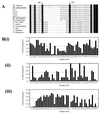Rhodospirillum rubrum possesses a variant of the bchP gene, encoding geranylgeranyl-bacteriopheophytin reductase
- PMID: 11872709
- PMCID: PMC134874
- DOI: 10.1128/JB.184.6.1578-1586.2002
Rhodospirillum rubrum possesses a variant of the bchP gene, encoding geranylgeranyl-bacteriopheophytin reductase
Abstract
The bchP gene product of Rhodobacter sphaeroides is responsible for the reduction of the isoprenoid moiety of bacteriochlorophyll (Bchl) from geranylgeraniol (GG) to phytol; here, we show that this enzyme also catalyzes the reduction of the isoprenoid moiety of bacteriopheophytin (Bphe). In contrast, we demonstrate that a newly identified homolog of this gene in Rhodospirillum rubrum encodes an enzyme, GG-Bphe reductase, capable of reducing the isoprenoid moiety of Bphe only. We propose that Rhodospirillum rubrum is a naturally occurring bchP mutant and that an insertion mutation may have been the initial cause of a partial loss of function. Normal BchP function can be restored to Rhodospirillum rubrum, creating a new transconjugant strain possessing Bchl esterified with phytol. We speculate on the requirement of Rhodospirillum rubrum for phytylated Bphe and on a potential link between the absence of LH2 and of phytylated Bchl from the wild-type bacterium. The identification of a second role for the fully functional BchP in catalyzing the synthesis of phytylated Bphe strongly suggests that homologs of this enzyme may be similarly responsible for the synthesis of phytylated pheophytin in organisms possessing photosystem 2. In addition to bchP, other members of a photosynthesis gene cluster were identified in Rhodospirillum rubrum, including a bchG gene, demonstrated to encode a functional Bchl synthetase by complementation of a Rhodobacter sphaeroides mutant.
Figures





References
-
- Addlesee, H. A., L. C. D. Gibson, P. E. Jensen, and C. N. Hunter. 1996. Cloning, sequencing and functional assignment of the chlorophyll biosynthesis gene, chlP, of Synechocystis sp. PCC 6803. FEBS Lett. 389:126-130. - PubMed
-
- Alberti, M., D. H. Burke, and J. E. Hearst. 1995. Structure and sequence of the photosynthesis gene cluster, p. 1083-1106. In R. E. Blankenship, M. T. Madigan, and C. E. Bauer (ed.), Anoxygenic photosynthetic bacteria. Kluwer Academic Publishers, Dordrecht, The Netherlands.
Publication types
MeSH terms
Substances
Associated data
- Actions
LinkOut - more resources
Full Text Sources
Molecular Biology Databases

